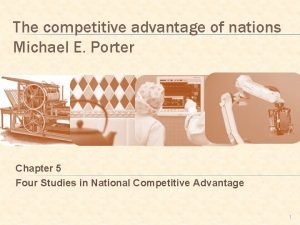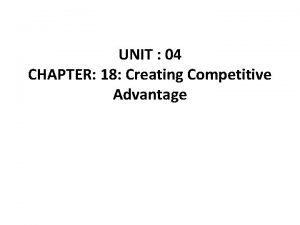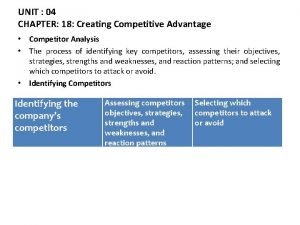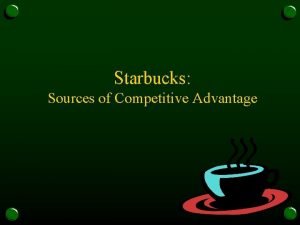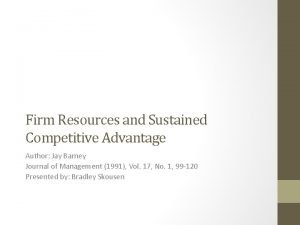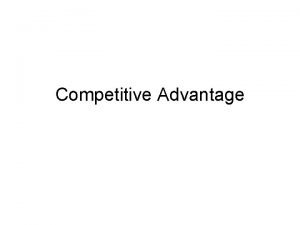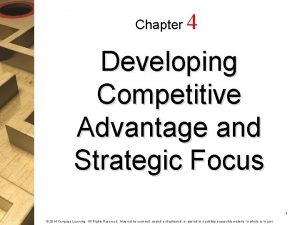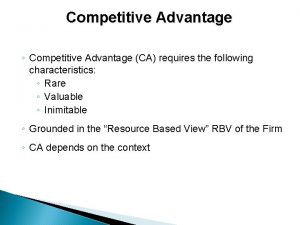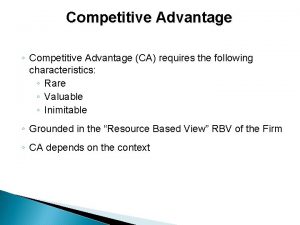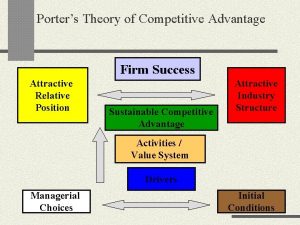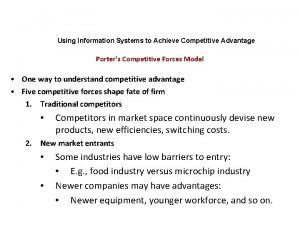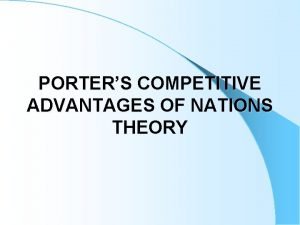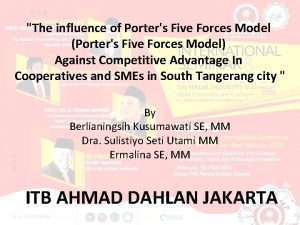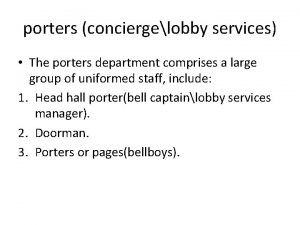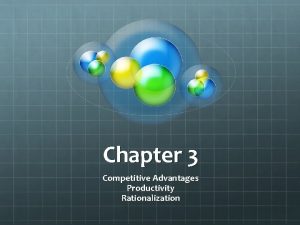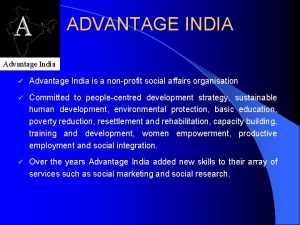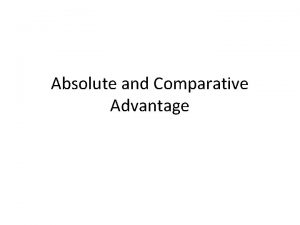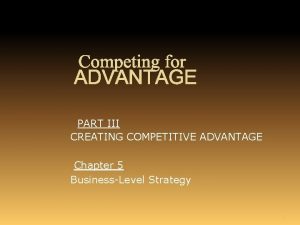Chapter 9 Porters the competitive advantage of nations





















- Slides: 21

Chapter (9) Porters : the competitive advantage of nations.

• Porter argued that a nation can create new advanced factor endowments such as skilled labor, a strong technology and knowledge base, government support and culture. A nation’s competitiveness depends on the capacity of its industry to innovate and upgrade. Companies gain advantage against the world’s best competitors because of pressure and challenge. They benefit from having strong domestic rivals, aggressive home-base suppliers, and demanding local customers. • According to Porter, a nation attains a competitive advantage if its firms are competitive. Firms become competitive through innovation. Innovation can include technical improvements to the product or to the production process. Porter used a diamond shaped diagram as the basis of a framework to illustrate the determinants of national advantage. This diamond represents the national plying field that countries establish for their industries.

• Information plays a large role in the process of innovation and improvement information that either is not available to competitors or that they do not seek, it comes simple investment in R&D or market research, or from effort and from openness and from looking in the right place. The only way to sustain a competitive advantage is to upgrade it to move to more sophisticated types. (i. e. Japan cars). • Two additional prerequisites for sustaining competitive advantage: 1. A company must adopt a global approach to strategy. It must sell its product worldwide, under its own brand name, through international marketing channels that it controls. This approach require the company to locate production or R&D facilities in other nations to take advantage of lower wage rates, to gain or improve market access, or to take advantage of foreign technology. 2. Creating more sustainable advantages often means that a company must make its existing advantage obsolete even while it is still an advantage.

The Diamond - Four Determinants of National Competitive Advantage 1. 2. 3. 4. Factor conditions (i. e. the nation's position in factors of production, such as skilled labour and infrastructure), Demand conditions (i. e. the nature of home-market demand for the industry's product or service, sophisticated customers in home market), Related and supporting industries, the presence or absence in the nation of supplier industries and other related industries that are internationally competitive. Firm strategy, structure and rivalry (i. e. conditions in the nation governing how companies are created, organize, and managed, as well as the nature of domestic rivalry).


1. Factor Conditions • By factor condition: it is meat the nations position in terms of factors of production such skilled labor or infrastructure necessary to compete in a given industry. Most of the factors of production that are required in today’s sophisticated and knowledge-intensive industries are created factors (such as skilled human resources or a scientific base). thus a nation does not inherit but instead creates the most important factors of production. This is in contract to the old doctrine of factors of production labor, land, natural resources, capital, infrastructure. Evan educated workface is not enough what matters most is specialized workface e. g. in chemical industries, optics………. etc. • Governments may have an important role in creating or supporting the creation of factors of production by funding training and support specialized scientific institutions.

2. Demand Conditions • Porter argues that a sophisticated domestic market is an important element to producing competitiveness. Firms that face a sophisticated domestic market are likely to sell superior products because the market demands high quality and a close proximity to such consumers enables the firm to better understand the needs and desires of the customers. • Nations gain competitive advantage in industries where the home demand gives their companies a cleared or earlier picture of emerging buyer needs, and where demanding buyers pressure companies to innovate faster and achieve more sophisticated competitive advantages than their foreign rivals. • Demanding and sophisticated consumers in the home market can pressure companies to meet high standards and innovate faster that their foreign rivals. Government policy can aid this process by instituting and enforcing strict product, safety and environmental standards. • Government policy can aid this process by instituting and strict product safety and environmental standards

3. Related and Supporting Industries • Innovation may require consideration interaction between, a firm, and its users or supplies and between firms themselves. Geographies and cultural closeness can be crucial factors in this process: agents located near each other can take advantage of shorter lines of communication and an ongoing exchange of ideas and information which may also be helped by the development of dose and high-trust working relationship. • The illustration of the Italian footwear cluster (fig. 9. 2) offers a graphic example of how a group of dose-by, supporting industries creates competitive advantage in a range of interconnected industries that are all internationally competitive

4. Firm Strategy, Structure and Rivalry • National circumstances and context create strong tendencies in how companies are created, organized, and managed, as well as what the nature of domestic rivalry will be. Government policy can influence a firm’s behavior through its taxation policies towards long-term investment and through the nature of its competition policies. Competitiveness in a specific industry results from convergence of the management practices and organizational modes favored in the country and the sources of competitive advantage in the industry. A. Strategy ( such as Capital Markets ) B. Structure C. Rivalry

A. Strategy ( such as Capital Markets ) • Domestic capital markets affect the strategy of firms. Some countries’ capital markets have a long-run outlook, while others have a short-run outlook. Industries vary in how long the long-run is. Countries with a short-run outlook (like the U. S. ) will tend to be more competitive in industries where investment is short-term (like the computer industry). Countries with a long run outlook (like KSA) will tend to be more competitive in industries where investment is long term (like the Oil industry). Company goals reflect the characteristics of national capital markets and the compensation practices for managers

B. Structure • Porter argues that the best management styles vary among industries. Some countries may be oriented toward a particular style of management. Those countries will tend to be more competitive in industries for which that style of management is suited. Individual motivation to work and expand skills is also important to competitive advantage. For example, Germany tends to have hierarchical management structures composed of managers with strong technical backgrounds and Italy has smaller, family-run firms.

C. Rivalry • Porter argues the presence of strong local rivals is a final, and powerful, stimulus to the creation and persistence of competitive advantage. Competition is particularly strong in Japan, where many companies compete strongly in most industries. Domestic rivalry, like any rivalry, creates pressure on companies to innovate and improve. Local rivals push each other to lower costs, improve quality and service, and create new products and processes, also will keep each other honest in obtaining government support

The Diamond as a System 1. The effect of one point depends on the others. For example, factor disadvantages will not lead firms to innovate unless there is sufficient rivalry. The diamond also is a self-reinforcing system. For example, a high level of rivalry often leads to the formation of unique specialized factors. At the broadest level, weaknesses in any one determinant will constrain an industry’s potential for advancement and upgrading. But the points of the diamond are also self-reinforcing: they form a system. Two elements, domestic rivalry and geographic concentration, have especially great power to transform the diamond into a system – domestic rivalry because it promotes improvement in all the other determinants, and geographic concentration because it elevates and magnifies the interaction of the four separate influences.

The Diamond as a System 2. Another effect of the diamond’s systemic nature is that nations are rarely home to just one competitive industry, rather, the diamond creates an environment that promotes clusters of competitive industries. Competitive industries are usually linked together through vertical (buyer-seller) or horizontal (common customers, technology, channels) relationships. One competitive industry helps to create another in mutually reinforcing process. Porter provides a somewhat detailed example to illustrate the system. The example is the ceramic tile industry in Italy. Porter emphasizes the role of chance in the model. Chance events can either benefit or harm a firm’s competitive position. These can be anything like major technological innovation or inventions, acts of war and damage, or dramatic shifts in exchange rates. One might wonder how agglomeration becomes self-reinforcing…

The role of government • The government plays an important role in Porter’s diamond model. Like everybody else, Porter argues that there are some things that governments do that they should not, and other things that they do not do but should. He says, "Government’s proper role is as a catalyst and challenger; it is to encourage - or even push companies to raise their objectives and move to higher levels of competitive performance …"

The role of government to support the diamonds: 1. Focus on specialized factor creation Government should provide national infrastructure like education or research institutions connected with industry and encourage privet investment to create factors. 2. Avoid intervention in factor and currency market Intervene to create lower factor cost or favorable exchange rate that help firm to compete internationally 3. Enforce strict product, safety and environmental standards Enforce strict product, safety, and environmental standards which pressure companies to upgrade technology, improve quality and provide features that respond to consumer demands. 4. Limit direct cooperation among industry rivals • Allowing more cooperative R&D to achieve economy of scale to reduce duplication of resources and cost

The role of government to support the diamonds: 5. Promote goals that lead to sustained investment Government shape the goal of firms to encourage innovative creation to encouraging investment in human skill and assets 6. Deregulate competition Through maintain monopoly, restricting entry leading to static market structure and less dynamics. 7. Impose strong domestic antirust policies Real national competitiveness requires policies to disallow merger and alliance because they reduce the incentive to innovate. 8. Reject managed trade Managed trade guaranteed markets for inefficient companies, so trade agreement would reduce motivation to innovate. Therefore, Policies should follow open market access to every foreign nation and remove its barriers.

The role of company policy to support diamonds: 1. Create pressure for innovation: A company should expose them selves to challenges to have incentive to innovate and sell to customer with difficult needs or provide material from advanced suppliers. 2. Seek out the most capable competitors as motivators Company should be dynamic and meet new challenges by studying and respecting competitors and compete with them 3. Establish early-warning systems Company had to investigate new buyers, competitors and maintain relation with research centers 4. Improve the national diamond For international success firm had to improve their national position through forming clusters and deal with local buyers, suppliers to help them upgrade.

The role of company policy to support diamonds: 5. Welcome domestic rivalry To compete globally companies had to have domestic rivals to create incentive to innovation 6. Globalize a tap selective advantage in other nations Innovation to support local diamond is better than outsourcing, that is developing local suppliers is better than depending on one foreign supplier. While foreign activities are selective and only used to support the competitive advantage, e. g. establish R&D overseas. 7. Use alliance only selectively Most alliance with foreign companies is short term, to benefit from foreign capabilities. It requires cooperation between two operations and reconciling goals 8. Locate the home base to support competitive advantage If the national state not supporting companies then they had to move else where to achieve economy of scale

Government policy • Government policy can support each factor in this diamond; in factor conditions, supporting specialized scientific institutions. In demand condition, government policy can aid this process by instituting and enforcing strict product, safety and environmental standards. In related and supporting industries, government policy may support the formation of regional and national clusters by encouraging the creation of appropriate regional infrastructure. In firm's strategy, structure and rivalry, government policy can influence a firm's behavior in this respect in various ways, such as through its taxation policies towards long-term investment and through the nature of its competition policies. • Government policy needs to take account of how the four elements of the diamond interact with each other, and try to ensure that they reinforce and complement each other, to increase the capacity of a nation to innovate and upgrade.

The role of leadership • Leaders believe in change, they energize their organizations to innovate continuously, and energize the importance of their home country as integral to their competitive success and work to upgrade it. Leaders recognize the need for pressure and challenge, because they are willing to encourage appropriate and painful government policies and regulations.
 Competitive advantage of nations summary
Competitive advantage of nations summary Porter's competitive strategies
Porter's competitive strategies Competitive dynamics examples
Competitive dynamics examples Chapter 18 creating competitive advantage
Chapter 18 creating competitive advantage Competitor centered company
Competitor centered company Chapter 2 strategic planning for competitive advantage
Chapter 2 strategic planning for competitive advantage Chapter 18 creating competitive advantage
Chapter 18 creating competitive advantage Chapter 18 creating competitive advantage
Chapter 18 creating competitive advantage What is the least competitive market structure
What is the least competitive market structure Therapeutic index
Therapeutic index Jay b barney
Jay b barney Generic strategy of starbucks
Generic strategy of starbucks What is starbucks competitive advantage
What is starbucks competitive advantage Human resources management gaining a competitive advantage
Human resources management gaining a competitive advantage Human resource management gaining a competitive advantage
Human resource management gaining a competitive advantage Human resource management gaining a competitive advantage
Human resource management gaining a competitive advantage Levi's competitive advantage
Levi's competitive advantage Barney 1991 firm resources
Barney 1991 firm resources Quotes on competitive advantage
Quotes on competitive advantage Bases of competitive advantage
Bases of competitive advantage Generic building blocks of competitive advantage
Generic building blocks of competitive advantage Developing a firm's strategy canvas focuses on
Developing a firm's strategy canvas focuses on
